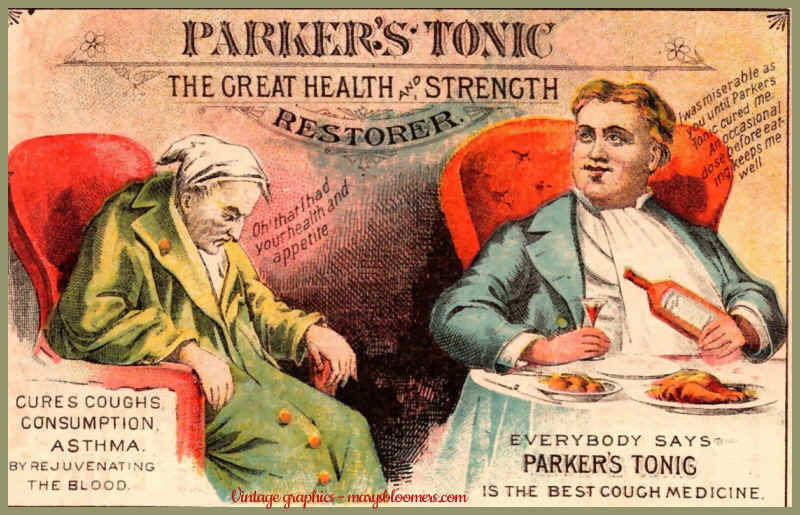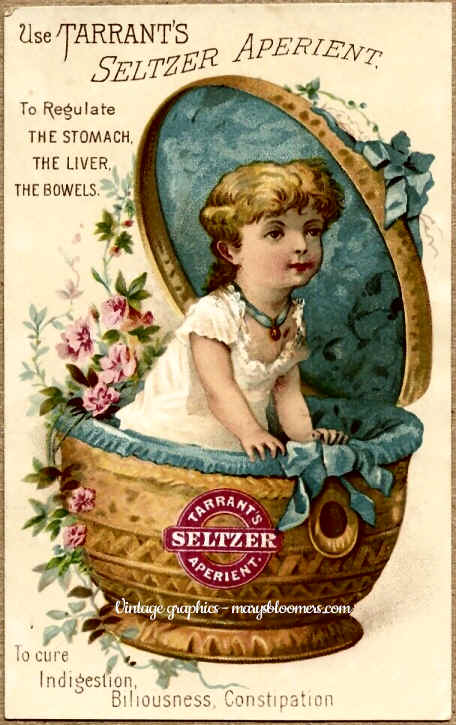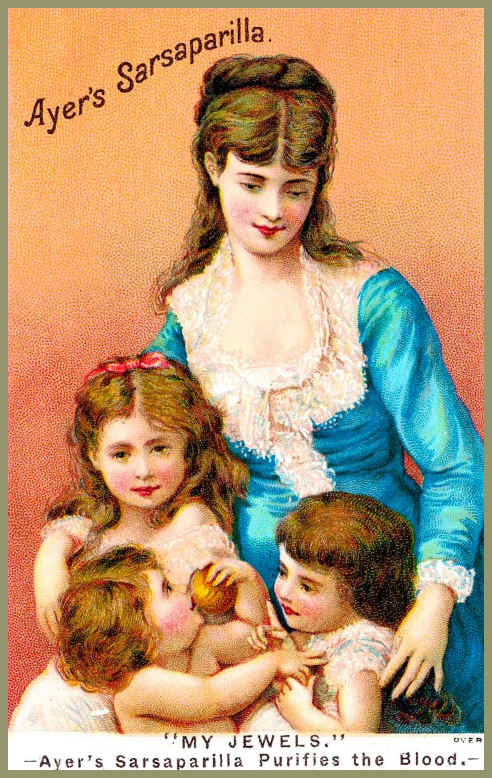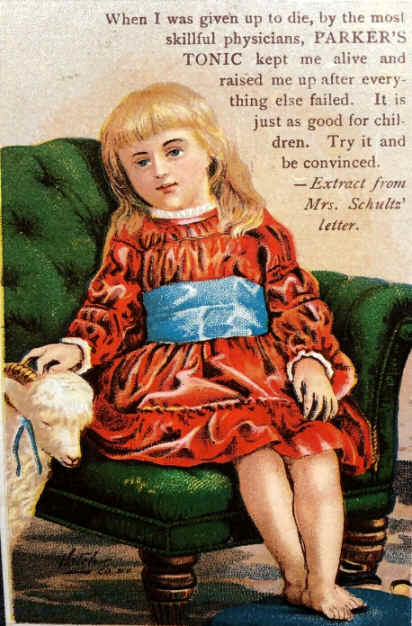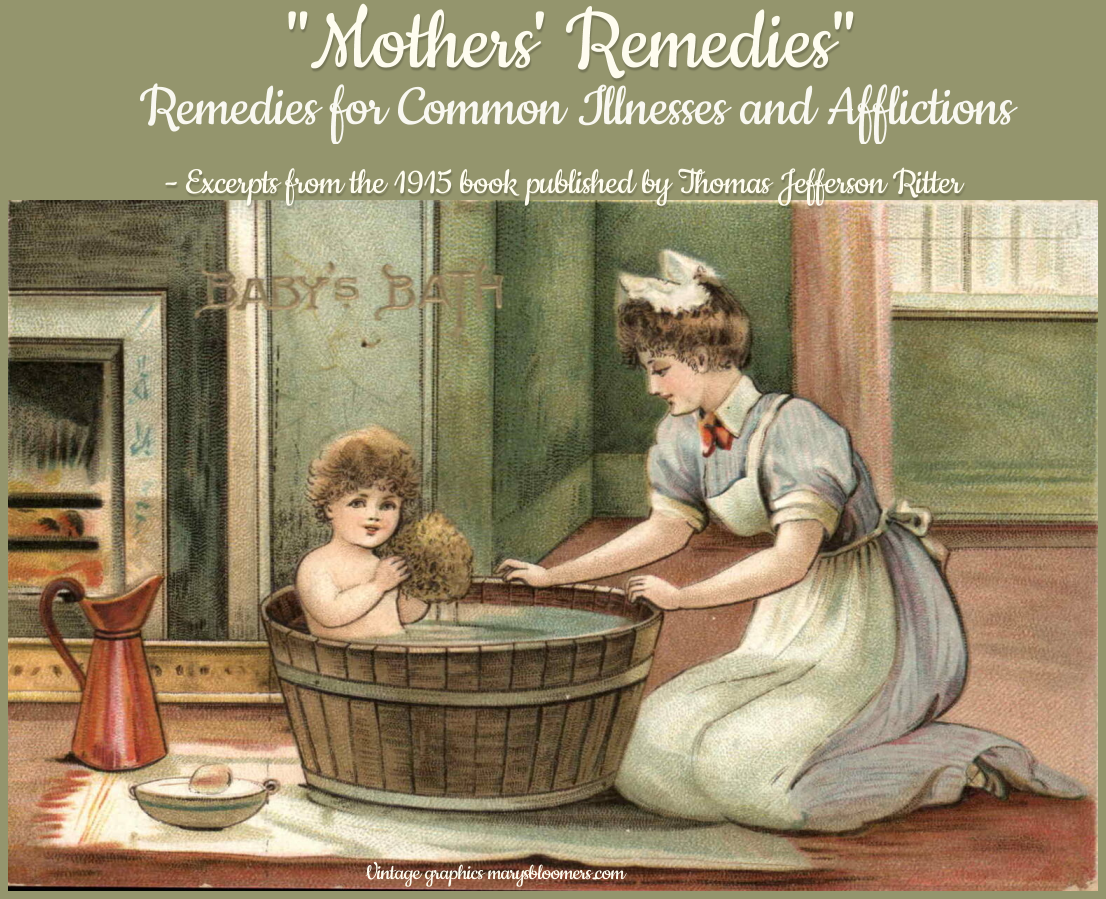 |
| For fun, I've added a few Victorian trade cards
advertising pharmacological cures promoted for various maladies. I did not change or edit any spelling or grammer. I left this is as it was written. IMPORTANT This article is for information purposes only. It defines allegedly tried-and-true remedies used and recommended by mothers in U.S. and Canada. I find these types of literature fascinating. This article IS NOT intended as medical advice or recipes you should try. From what I can tell from reading some of the remedies of the day, and chemicals recommended, i wouldn't experiment on a human being, without a professional medical practitioner to verify safety of the ingreients. Some suggestions are safe, and still in use today, as home remedies. Some sound just plain bizarre to me. Like concoctions containing alcohol, borax, kerosene, turpentine, benzene and other chemicals I wouldn't dare make my family take or apply these. Hemlock is absolutely out of the question. Chloroform in an oil spray in the nose is just not going to happen. Although I am somewhat amused by the fact that it probably introduces quiet around the house. The oddities and herbals are the reasons i wanted to create this page. There are also home remedies mentioned in this book, derived from herbs that are quite curative, valid and valued as medicines today. **Many of the herbal remedies listed in this publication are still in use, and are said to be safe and effective. But don't take just anyone's word for it. Bunions, Remedy from
Your Flower Garden 1. Indigestion or Dyspepsia, Mustard and Molasses for.—"Mustard is an excellent household remedy kept in every home. A tablespoonful of white mustard mingled with two ounces of molasses and then taken once a day will act gently on the bowels and is a beneficial remedy in dyspepsia." By acting upon the bowels it relieves the stomach of any food that may have caused a disturbance and relieves the dyspepsia. 2. Flatulent Dyspepsia, Wormwood tea for.—"Wormwood, one to two teaspoonfuls, water one pint. Make a tea and take from one to four teaspoonfuls daily." This is an old tried remedy and one that should be given a trial if affected with dyspepsia. 3. Indigestion or Dyspepsia, Dry salt for.—"One-half teaspoon dry salt taken before each meal. Knew a gentleman who was nearly worn out with this trouble and entirely cured himself with this simple remedy." It is always well to give these simple remedies a fair trial, before resorting to strong drugs. Salt is a good stimulant. 4. Indigestion or Dyspepsia, Chicken Gizzard Skin for.—"Four ounces good brandy, one-fourth pound of loaf sugar, one tablespoonful pulverized chicken gizzard skin, one teaspoonful Turkish rhubarb dried on paper stirring constantly; this prevents griping; the chicken gizzard skin is the lining of the gizzard which should be thoroughly cleaned and dried then pulverized. To prepare put brandy and sugar together (crush the sugar), light a paper and set fire to the brandy; let burn until sugar is dissolved, then add the gizzard skin and rhubarb, stir together and if too thick add a little water and boil up. Dose :—Infant, one-half teaspoonful every four hours; child, one teaspoonful every four hours; adult, one tablespoonful every four hours. Have used this remedy for a great many years and given it to a great many people who have worn out all other remedies."
SORE THROAT (Acute
Pharyngitis—Acute Pharyngeal Catarrh—- Inflammation of the Pharynx—Simple
Angina). Symptoms.—The throat is dry and feels stiff. There may be tenderness at the angle of the jaw and outside of the neck. Pains some to swallow. In a day or two there is a mucous secretion, making the patient inclined to clear the throat by hawking or coughing. The throat looks red and in the early stage this is more noticeable on the anterior pillars of the fauces, the soft palate and uvula. On the back wall you see bright red spots, the inflamed lymph follicles. It usually gets well in two to seven days. It may become chronic after repeated acute attacks. Chronic.—This is very common in persons who smoke or drink to excess, also people who use their voice in public speaking as preachers do, or in calling loudly as hucksters, railroad brakemen, stationmen, etc. Prevention of chronic kind.—Ascertain the cause and remove it. Too hot food or too much spiced food cause the chronic kind. Rest the voice. Remove any existing catarrh. Prevention of acute kind.—Avoid undue exposure to cold and wet, wear warm comfortable flannel underwear. Bath the neck and chest daily with cold water. This is good cold preventive. The wearing of handkerchiefs, mufflers, around the neck is injurious unless you are driving. Accustom your neck to the cold from the beginning in the fall and winter months. Wearing a full beard is said to be a good preventive. Remedies 1. Sore throat, Used for Years Successfully.—"Salt pork dipped in hot water then covered thick with black pepper. Heat in the oven and lay or bind on the throat or lungs. This has been a favorite remedy with us for years." Sew the pork to a piece of cotton cloth and bind over the sore parts after you have sprinkled the pork with salt and pepper. Leave this on as long as the patient can endure it. When the pork is removed, rub the affected parts with cold cream or vaselin and put a clean muslin cloth on to keep person from taking cold. 2. Sore throat, Splendid Liniment for.— "Olive oil 1/2 pint This is a very effective remedy, but you must watch the throat very carefully as this will blister quickly. After removing the liniment, grease the parts with oil or cold cream. 3. Sore throat, Simple Gargle for.— "Soda 1 teaspoonful This is a very good gargle. It contracts the parts and acts as an antiseptic and thoroughly cleanses the parts. 4. Sore throat, Home Made salve for.- "Beeswax 1 ounce 5. Sore Throat, Cold Packs, Sure Cure for "Put cold packs on the throat. Gargle with very hot water and a little soda. This makes it very effective. 6. Sore Throat, Ointment for Oil Turpentine 1/2 ounce 7. Sore Throat, Remedy from a mother in Johnson City, Tenn.—"Fat meat stewed in vinegar and bound to the neck. 8. Sore Throat, Gargle and Local Application for Common salt 2
tablespoonfuls Use as a gargle. External applications, wring a cloth out of salt and cold water and keep it quite wet, bind tightly about the neck and cover with a dry cloth. It is best to use this at night." 9. Mild Sore Throat, Vinegar Gargle for.—"Gargle with vinegar and hot water. This will help to sooth the irritation and in a mild sore throat is a sure cure." 10. Sore Throat, Alum and Vinegar for.—"One glass of warm water; one tablespoonful of vinegar; one teaspoonful of sugar; one-half teaspoonful of alum; dissolve well and gargle throat several times daily." 11.
Sore Throat, Kerosene for 12. Sore Throat and Cough, Remedy always at hand.—"Equal parts of alcohol and glycerin make a good gargle, or use three tablespoonfuls of vinegar and one of salt to a tumbler of water. Or simply hot water and salt when nothing else is to be had. The hot water alone is very good." 13.
Tickling in Throat, Simple Remedy for
Causes.—Exposure to cold or wet when the body is overheated; sudden or extreme changes in the atmosphere; inhaling irritating fumes or dust. Symptoms.—A
chilly feeling, limbs ache, tendency to sneeze, severe headache above
the nose, eyes are dry, stopped-up feeling in the nostrils. Then there
is a thin watery discharge, usually of an irritating character, very
thin at first, but it soon becomes thicker; sometimes the ears ring
(tinnitus). The nose and lining is red and swollen. 2.
Colds, Valuable Caution and Treatment for.—Mrs.
Maxwell, of Cleveland, writes in the Cleveland Press as follows:
"If you intend to treat the cold yourself, take it up at the
outset. Don't wait for it to develop. To break it up, nothing is better
than the full hot bath at bed time, or the foot bath with mustard,
followed by a hot drink. It is old-fashioned, but scientific, for nine
colds out of ten are due to clogged pores. 3. Colds, Molasses-Vinegar Syrup for.—"One-half cup of molasses, butter the size of a hickory nut, one tablespoon vinegar, boil together. Dose: One teaspoonful or less as the case requires. Take often until relieved." This is an old remedy and a good one. 4. Colds, Quinine and Ginger for.—"Give plenty of quinine and drink hot water with ginger in it." Quinine, as we all know, is an old remedy for colds and therefore we all know how it acts. The ginger warms up the system and produces sweating. Care should be taken when using this remedy not to take cold, as the pores are all opened by the quinine. 5. Colds, Boneset for.—"Boneset tea steeped and drank cold cures a cold." Boneset simply acts by causing a better circulation in the system and in that way sweating is produced and we all know that a good sweat will usually cure a cold if taken in time. 6. Severe Cold or Threatened Consumption.—"One pint of molasses; one pint of vinegar; three tablespoonfuls of white pine tar; let this boil not quite half down; remove from the stove and let stand until next day; then take and skim tar off from the top, throwing tar away. Jar up and take as often as necessary. Spoonful every half to two hours." 7. Colds, Rock Candy Syrup for.—"Ten cents worth of rock candy; one pint of whisky; one pint of water; fifteen cents worth of glycerine; mix all together; this will syrup itself." Take one teaspoonful as often as necessary. This is excellent. 8. Colds, Skunk's Oil for.—"Skunk's oil has cured colds quickly by rubbing on chest and throat." The oil penetrates quickly and relieves the congestion. This remedy can always be relied upon. 9. Colds, Lemons and Mustard for.—"A hot lemonade taken on going to bed and put the feet in a hot mustard bath; taken in time will break up a cold." The idea of the foot bath is to equalize the circulation, as so many of our colds begin in the head and by drawing the blood from the head the congested parts of the head are relieved. 10. Colds and Cough, Hops or Catnip Poultice for.—"Hops or catnip put in little bags and steamed until hot, then placed on lungs and throat." This is a very good remedy, as the hot bags act as a poultice and draw the congestion from the diseased parts. It produces not only local, but general perspiration. 11. Colds, Honey for.—"Eat honey. I have tried this many times and it is very good." The honey is very soothing, but if a little hoarhound or lemon is added it would make it much more effective. This is a good remedy for children, as they most all like honey. 12. Colds, to Break Up at the Outset.—"To break up a cold soak the feet in hot water and drink all the cold water you can." This has been known to cure many severe colds if taken at the beginning. 13. Cold in the Chest, Mutton Tallow and Red Pepper for.—"If cold is in the chest, render enough mutton tallow for one cupful and add one teaspoonful of red pepper and rub on chest and apply a flannel to keep out the cold. This is an old-time remedy and a good one." 14. Colds, Lard and Turpentine for.—"Melt a half cupful of lard and add one and one-half teaspoonfuls of turpentine, rub on chest and apply flannel cloth." 15. Colds, Milk and Cayenne as a Preventive.—"Drink a glass of milk with a pinch of cayenne in it. This will warm the stomach and prevent headache." RESPIRATORY DISEASES1. Camphor and Vaseline Mixed, or Camphor and Cream, rubbed in the nose is good to stop the cold and soreness. 2. A few drops (two or three) of camphor taken internally every three hours will abort some colds, especially if the nose is all the time pouring out drops of water. 3. Aconite in small doses, one-tenth of a drop, every two hours is a splendid remedy at the beginning. My experience has shown me that aconite does better work in these small doses. Put one drop in ten teaspoonfuls of water and give one teaspoonful at a dose. 4. The following is good for a thick discharge: in oil spray. Menthol 6 grains To cleanse the nostrils wash out each nostril gently with a solution made of one teaspoonful of listerine, or glyco-thymoline, or borolyptol, or one-quarter teaspoonful of common salt in a half glass of warm water. You can use a vaporizer and this solution: Menthol 5 grains Never snuff a solution into the nose, and do not blow the nose hard after using. Some of the solution or nasal discharge may be forced into the eustachian tube. 5. Lard or camphorated oil rubbed on the nose and throat twice a day is good. 6. To Restore the Loss of the Voice.— Oil of wintergreen 2 drams 7. Put a quart of boiling
water in a pitcher; add from two to four drams of the compound tincture of benzoin and inhale the
hot vapor. 8. Herb Teas for.—Ginger tea, catnip, hoarhound, pennyroyal, etc.; hot, are all good to produce sweating and thus relieve cold. 9. From Dr. Ball, a London, England, Specialist.— Menthol 30 grains 10. When the stage is rather marked or prolonged, spray or syringe out the nose with tepid solution once or twice a day using the following: Bicarbonate of soda 3 to 5
grains CATARRH.
(Chronic Inflammation of the Nose, Chronic
Rhinitis).
Symptoms and Course.—There
are alterations of the secretions: the amount varies in the same case at
different times. Sometimes it is thin and watery, or thick, sticky mucus
or this may alternate with more watery discharges. Patients frequently pick the nose for this crust and ulceration may result at that point from its doing. Bleeding often occurs from picking the scales from the ulcers, and perforation of the partition may take place from extension of the ulceration. There is a feeling of stuffiness. There is some obstruction to breathing. If there is much thickness of the structures, nasal obstruction is a persistent symptom. Changed voice, mouth-breathing, etc., are noticed. A sensation of pain or weight across the bridge of the nose is sometimes complained of and this symptom is especially found associated with enlargement of the middle turbinated body on one or both sides, etc. 1. Catarrh, Successful remedy for.—- "Dissolve in one-half ounce olive oil as much camphor gum as it will take up. Moisten a little finger with the oil, rub into the nostrils and snuff well up into the head." The olive oil is very soothing to the diseased parts and the camphor contracts the swollen mucous membranes, thereby relieving the catarrh. This is an excellent remedy. 2. Catarrh, Cleansing Antiseptic Remedy for.—"Snuff about one teaspoonful of salt in cup of warm water every morning in nostrils. I have found this remedy simple but fine for catarrh and also having sleeping room well ventilated summer and winter will help in curing disease." This remedy will be found very effective in catarrh because it loosens up the secretions and cleanses the nose of the foul secretions and also has an antiseptic action. This can be used twice daily. Snuffing should be done very gently so as not to draw the water too far back. 3. Catarrh, Witch-Hazel for.—"Pond's extract applied with nose spray." Pond's extract is simply witch-hazel water and everyone knows that witch-hazel water is healing and soothing to the membranes of the nose. This may be used regularly twice a day. 4. Catarrh, Cure for.— Menthol 10 grains 5. Catarrh of head, Mullein Leaves. Treatment, etc., for.—"Smoke dried mullein leaves and blow the smoke through the nose, and in addition to this, put a heaping tablespoonful of powdered borax in a quart of soft water; syringe this up in the nose, and in addition to both of the above, frequently inhale a mixture of two drams of spirits of ammonia, half a dram tincture of iodine and fifteen drops of carbolic acid; smoke the mullein, syringe the borax water and inhale the last mixture all as frequently as convenient and it frequently will cure if kept up faithfully." 6. Catarrh, Milk and Salt Wash for.—"Mix together one teaspoonful common salt, a teacupful milk, and half pint of warm water. Inject this into the nostrils three times a day. You may use the same quantity of borax in place of the salt, if you choose to do so." 7. Spray for.—After cleansing the nostrils with the solution the following soothing mild spray will be found of great benefit. Menthol 5 grains 8. Powders for.—Antiseptic powders are also very useful in some cases, such as, compound stearate of zinc and boric acid, or compound stearate of zinc and alum or compound stearate of zinc and menthol. One or two drams is enough to buy at once as it is very light; always use it in a powder in the following way: First take a long breath and while holding the breath, puff some of the powder into each nostril; then gently puff the breath out through each nostril. Do not snuff powder up the nose or use the powder-blower while breathing. If this is done, some will get into the pharynx and larynx and cause annoying coughing. 9. Solution for.— Bicarbonate of soda 1/2
ounce 10. Spray, for.— Bicarbonate of soda
1-1/2 drams Use as a spray. OZENA.—(Foul odor from nose, not breath, due to catarrh of the nose). The membrane is dry and shrunken. It is a very offensive odor, thus called "ozena." Causes.—It is usually
seen in people who are very much debilitated, in young factory girls,
and sometimes in healthy boys. Retained secretions in the nose, usually
cause the odor. These decompose and ferment. The nose is large and
roomy, the nostrils are filled with scabby secretions; hard masses are
formed which sometimes fill the nostril. 2. Hay fever, Remedy
Worth Trying for. 3. Hay fever, Our
Canadian Remedy for.— 4. Hay Fever, Medicine
That Helps. NOSEBLEED 2. Nosebleed, Alum as a
cure for. 3. Nosebleed; Remedy
that succeeded in a severe case. 4. Nosebleed, Simple
Remedy for. 5. Nosebleed, Another
Home Remedy for. 6. Nosebleed, Puff-Ball
for. 7. Nosebleed, Vinegar
and Water for. HOARSENESS. Inflammation of the Larynx. (Acute Laryngitis) Causes.—Due to taking cold or over using the voice; hot liquids, poisons. It may occur in influenza and measles; from irritating gases; some are subject to it. Symptoms.—Tickling in the larynx; cold air irritates, and breathing may cause some pain; dry cough; the voice may be altered. At first it may be only husky. In children breathing may be very difficult, after a day or two there may be a light expectoration and finally there may be a loose cough and a slight fever. The trouble is in the region of "Adam's Apple." There is little or no danger in these attacks if proper care is taken. The attack generally lasts two to four days. 1.Hoarseness, Borax
for. 2. Hoarseness, Egg and
Lemon for. 3. Hoarseness,
Horseradish for. 4. Hoarseness,
Successful Remedy for Adults. 5. Hoarseness, Lemon
and Sugar for Children. TICKLING
IN THROAT. 2. Tickling in Throat,
Good Northern Canada Remedy for. 3. Tickling in Throat,
Tested Gargle for. Strong Sage Tea 1 pint The above ingredients are all excellent for sore throat and it is an old tried remedy and can easily be obtained. If it is too strong dilute with warm water to the desired strength. "CHILD CROWING" (Spasm of the Glottis.)—This is usually peculiar to children. Cause.—It is purely a nervous affection and it occurs between six months and three years, and is most commonly seen in children with rickets. Symptoms.—It may come in the night or day; or when the child awakes. The breathing is arrested, the child struggles for breath, the face is flushed, and then with a sudden relaxation of the spasm, the air is drawn into the lungs with a high pitched crowing sound. Convulsions may occur. Death rarely occurs. There may be many attacks during the day. Cold Sponging. CROUP, Spasmodic. Symptoms.—Usually the child goes to bed perfectly well, or has a slight cold and wakes up an hour or two later, coughing and gasping for breath, due to a spasm in the wind pipe. The cough is shrill, more like a bark; the cough is repeated at intervals and soon the patient breathes quickly and laboriously. It must sit up for it can breathe easier sitting. The voice is oftentimes nearly or quite lost, or at least only a hoarse whisper; the face is bluish or perspiring. The spasm lasts for a variable period, but rarely exceeds one-half hour, sometimes only a few minutes. The croupy cough and oppressed breathing may last longer than this, but these too subside after a time, after which the child drops to sleep and usually rests quietly for the rest of the night. There is a tendency to recurrence on succeeding night unless obviated by treatment. Treatment.
Preventive.
1. Croup, Cold Application for. 2. Croup, Sure
Cure for. 3. Croup,
Immediate Relief from Steaming. 4. Croup, for
Baby or Older Child. 5. Croup,
Remedy that Never Fails. 6. Croup, Coal
Oil (kerosene) and Sugar for. 7. Croup, Pork and
Onion Poultice for. 8. Croup, Bloodroot
for. 9. Croup, Time
Honored Remedy for. 10. Croup, Ipecac
for.—"One-third teaspoonful of powdered ipecac dissolved in
one teaspoonful of water, one tablespoonful of sugar; pour on one
teacupful of boiling water and let boil down to a half cup, Dose: One
teaspoonful for adults; children in proportion every two hours; or, if
needed to vomit children, give again in ten or fifteen minutes." 11. Croup, Vaselin
for. 12. Croup, Ice
Application for. 13. Croup, Salt for. 14. Croup, Castor
Oil Breaks up. 15. Croup, Coal Oil,
Turpentine and Snuff, a Canadian Remedy for. I hope you enjoyed this article from a vintage household remedy publication. There are plenty more you can download for old-fashioned kitchen and gardening info, as well as recipes and a little history... click here to view the list of freebies.
Great Big Detailed Site Directory--> Photography,
content, graphics and design ©2005 and beyond This site uses Watermarkly Software |
